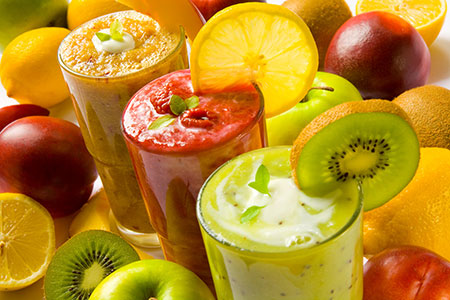Stick it in the blender and give it a whirl — everything will come out mixed up. That's what seems to be happening to the advice on blending our produce. Suddenly, there's a vortex of controversy swirling around smoothies. Some health advocates recommend smoothies, others are saying, "Maybe we should rethink our drink."
Increasing our intake of fruits and vegetables is almost never a bad thing — especially in a culture where the average person isn't eating even the recommended minimum five fruits and vegetables per day. So from that standpoint, I have to agree with Tracye McQuirter and say "By Any Greens Necessary," meaning we should take in the produce anyway we can. Transitioning to a plant-based lifestyle will vastly improve our odds of staying healthy and enjoying a longer life. But once we've made the switch to whole plant foods, there are some further steps we can take to optimize our health. And that's where the discussion of smoothies falls. If we're talking about optimal health, then we should probably rethink our drink. But for some people, "Them's fightin' words."
Stirring it up on the Happy Herbivore Blog

Happy Herbivore's Lindsay Nixon on her post "Why I Stopped Drinking Green Smoothies" says that she had to take down her original anti-smoothie post due to the large volume of comments it generated: "I really didn't expect it to cause such a stir, especially because other people have been blogging about this topic, too . ... As much as I have loved all the great questions, sweet emails, and debate about this topic, it's too distracting." Eventually, Lindsay was able to repost about the topic, summing up her position and linking to recognized authorities in the WFPB, no-added-oil community — such as Dr. Caldwell Esselstyn, Jr., and registered dietitian Jeff Novick, MS, writing for the McDougall Program — who have also taken a stand against smoothies and juicing.
Six Reasons Not to Process Your Produce
Fiber is a vital nutrient. Unlike juicing which completely removes fiber, whirling up whole foods in a blender does retain the fiber. However, the action of the metal blades modifies the fiber, making smoothies a less-than-ideal way to consume our fruits and vegetables.
Here are six reasons smoothies are not optimal for our health:
1. When fiber is broken down into small pieces in a blender, the particulate size is so tiny that the nutrients are easily absorbed into the blood stream, sending our blood sugar levels up quickly. Jeff Novick MS, RD, explains that blended fruits, starchy vegetables, or whole grains raises the blood sugar more than blended non-starchy vegetables like spinach or kale. However, most green smoothies incorporate fruit and other sweeteners to make the greens palatable, bringing us back to the problem of raised blood sugar.
2. Spiking levels of blood sugar (from the in-rush of nutrients due to the small particle size created by the blender) cause our body to release insulin into the bloodstream. The surge of insulin has two side effects: we feel hungrier sooner, and we store fat as adipose tissue on the body.
3. Elevated blood sugar causes the release of insulin-like growth factor 1 (IGF-1) into the bloodstream. The hormone IGF-1 is a growth promoter which speeds aging and indiscriminately promotes tissue growth, including the growth of cancerous tumors.
4. Beverages high in fructose — the sugar in fruit— raise triglycerides thus increasing our risk of conditions associated with metabolic syndrome: obesity, elevated cholesterol, heart disease, diabetes, and hypertension.
5. If calorie-dense foods such as nuts, seeds, avocado, nut butters, or coconut are added to the mix, smoothies become a sneaky way to add fat to our diet and our waistline.
6. Liquid calories do not satisfy as well as bulkier foods. Blended produce does not activate the stretch receptors of the stomach as much as solid fruits and vegetables do. The natural, intact fiber in an apple combined with its watery juices creates bulk which actives our stomach's stretch receptors. Without those receptors feeling the stretch caused by the bulky, intact fiber, we may overeat by drinking our produce thereby taking in far more calories than we need. If our smoothie accompanies a meal, we have further increased our caloric intake. Our bathroom scale will likely reflect a similar increase.
In my related article, "Crunching the Science on Juicing," I go into many of these issues and more in much greater detail. Please check it out. In that article, I explore more of the science which shows us that habitually drinking our produce doesn't lead to optimal health.
Put Away the Processor
Even though it happens on our own kitchen counter, when we use a blender to mince the fiber into minute pieces and mechanically separate it from the rest of the nutrients, we have processed our food, however slightly. We have made the nutrients available for rapid absorption into our bloodstream, which is generally part of the problem with processed foods of any kind.
This may be the first time you've thought about blending food as a form of processing. Or maybe you believe that smoothies are the only way a family member will be able to improve their intake of fruit or vegetables. I understand. Remember, when we talk about reducing or eliminating smoothies in our diet, we're talking about "optimal" health. If, however, you are struggling with weight management, if you are trying to control your blood sugar or your triglycerides, or if you are concerned about keeping your IGF-1 as low as possible, then I would suggest that smoothies may not be helpful in those cases. To optimize our health, it's best to rethink our drink.
Additional Information:
(1) Crunching the Science on Juicing
(2) Thomas Campbell, MD - Are Smoothies Good or Bad?
(3) Engine 2 - Skip the Fancy Drinks, Chew Your Food